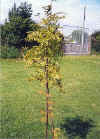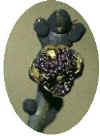 |
 |
 |
| Stop 14 on Trail 1 | Muddy brown and yellow autumn foliage. | Ash foliage with fruit or 'keys' in the background |

|
Typical black buds when leafless just opening in spring. |
Fuiseog ( Irish )
Fraxinus
excelsior
The Ash is some-times called the "Venus of the Woods", because of its
graceful form and beautiful foliage. It is an erect tree, which may grow to one
hundred feet in about one hundred and twenty years. The bark of the young tree
is smooth and grey, but as the tree gets older it becomes rougher and rather
darker. Leaves do not appear until May. The flowers appear before the leaves in
April, in loose clusters near the tips of the twigs.
Although hardy enough to survive anywhere, ash trees prefer valley bottoms and stream sides. They must have full light at all times and never be crowded out by other trees. They grow easily from seed but it must be collected and sown in early autumn while still green.
You can recognize trees by their leaves, which are divided into many pairs of leaflets with a single leaflet at the tip, and by the seeds with their long wings. In winter the Ash is easy to recognise by its hard black buds, which are borne in opposite pairs on the smooth grey-green twigs.
The English name ash is derived from aesc the Anglo-Saxon name for a spear, once a common use for 'ground ash' as young slender saplings were called. The name Fraxinus was given to the tree by the Romans. It seems likely to have been derived from the Greek phrasso meaning a fence. Ash, living or dead, has always been used for marking field boundaries.
The old Latin name for the seeds (ash keys) was lingua lavis meaning bird's tongue, which they closely resemble.
The timber is extremely tough and very pliable and is used for making hockey-sticks, walking-sticks, oars, and frames of large vehicles, like motorbuses. The very strong wood was used to make aircraft wings during the Second World War.
The ash tree is very popular in Ireland as the wood from the ash is used to make hurleys.
Here is a little rhyme about the ash and oak trees.
If the Oak be out
before the Ash
The summer will be but a splash;
If the Ash be out before the Oak
the summer will be a soak."
